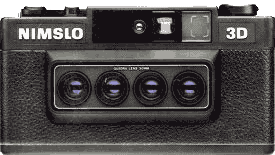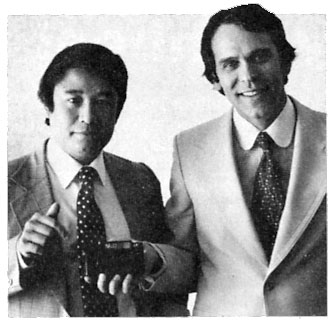
Approx. date of manufacture: 1981
Approx. original price: $200
Approx. street value: $25
When I first got into stereo photography, this camera was new. If I remember correctly it was around $200 and I couldn't afford it, but I spent a lot of time at the department store where it was on display looking at it. And when the company offered free sample photos, I wrote to them to get them. I still have them around here somewhere.
The camera wasn't a success. Years later you could get them for $25 brand new, in the box with the case and a (generic) flash, which is how I got mine.
 |
Dr. Jerry Nims and Allen Lo (in 2D) |
Nimslo's printers used lasers, so they decided to take four pictures instead of two, which gives you four different stereo pairs, not just one, so theoretically when you looked at the print from any angle, you'd get a stereo pair.
Didn't work, Well, it worked but not very well. I remember seeing baseball cards that did the same thing, and they weren't too swift either. Plus the printing cost was super high and you had to send it to their special plant in (I think) Florida. Most people who bought these cameras were stereophiles like me who ran slide film through them and mounted the pairs in cardboard slide holders, just like we did with our Realist cameras.
Nice little camera. Very compact, solid and seemingly well made. No controls, which made it far less capable than the better stereo cameras from the 50s, such as my Kodak Stereo, but it was a nice try.
I've seen articles on the internet where people are taking this camera and heavily modifying them to do other things. I think someone made it into a nice panoramic camera...
But just to show you that a bad idea never dies, variations of this camera, especially the four-lens concept, were carried on with the hideously-overpriced and just-as-devalued Nishika. Go figure.
One of Modern Photography magazine's Top Cameras
Camera manual: Orphan Cameras.com



